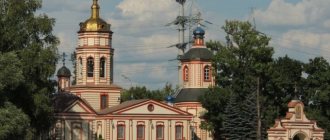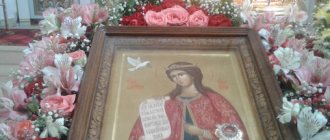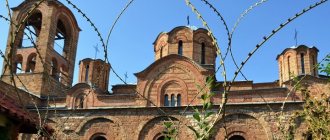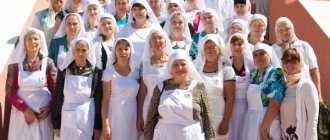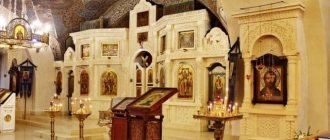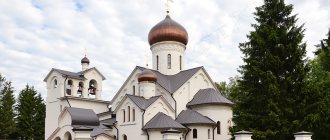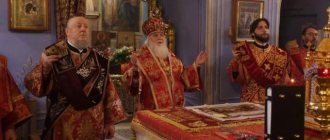| Temple of the Holy Martyr and Wonderworker Tryphon | |
| A country | Russia |
| City | Moscow |
| Year of foundation | 1492 |
| Website | www.triphon.ru |
| Abbot | Archpriest Feodor Semenovich Rozhik |
The Church of Tryphon in Naprudny is a temple of the Russian Orthodox Church, belongs to the Sretensky deanery of the Moscow city diocese.
There is a legend in which a certain falconer of a prince hunted in the places where the temple now stands. He tried to catch the prince's favorite bird, but he failed, and he was sent to prison for this. At night he prayed for a long time to Saint Tryphon, and in the morning he saw on his hand the very bird that he was supposed to catch.
The Church of the Martyr Tryphon is the oldest building preserved in Moscow outside the Kremlin. The church was built as a parish church.
The only ancient temple with a covered cross vault. The temple is located in the Meshchansky district - in Moscow, on Rizhskaya. His address: st. Trifonovskaya, 38, building 1.
According to legend, the temple was built on the site where the misfortune of the falconer Grand Duke happened
The Trifonov Church is considered the oldest of all the churches in Moscow outside the Kremlin that have survived to this day. The church was built as an ordinary parish church. According to legend, the falconer of the Moscow prince was hunting in these places and missed the prince’s favorite bird.
For this, the Grand Duke put him in prison. Then the falconer remembered that once Tryphon, the name of the saint had been known to him for a long time, also dealt with birds and began to pray to him. In a dream, the martyr Tryphon appeared to him and handed him a falcon in his hand. When he woke up, he saw the lost bird on his hand in front of him, after which he was freed from prison.
In gratitude for this, the falconer built a temple in the name of the martyr Tryphon in the place where the misfortune happened. People came to the icon of St. Tryphon from all over Moscow and beyond. This legend was captured in one of the frescoes of the temple at the end of the 15th century, which depicted a horseman with a falcon on his outstretched arm - Tryphon.
On this fresco, in one of the temples, the martyr Tryphon is depicted on a horse
From the history of the temple
One way or another, most researchers call the 1470s the most likely time for the construction of the temple. This means that our shrine is almost the same age as the Assumption Cathedral. In terms of antiquity, it is the second outside the Kremlin.
It is not surprising that the church is a whole storehouse of mysteries, both historical and architectural.
So, according to legend, the shrine was built by the falconer of Tsar the Terrible, Trifon Patrikeev.
During the hunt, Patrikeev lost a falcon, which could have cost him his life. The falconer began to sincerely pray to his patron, Saint Tryphon. In a dream, the image of a saint appeared to him and told him how to find the bird.
At this place, Tryphon built a temple in Naprudny in honor of his saint.
However, not all researchers are inclined to accept this version of the origin of the temple. True, it is supported by the fact that during this period many real architectural masterpieces were erected under Tsar Grozny.
It is simply impossible to equate the Trifonovskaya shrine with them, since the church is small, has poor decor and squat proportions, a “sloppy” plan, where even the walls are not parallel to each other.
It is difficult to imagine that the temple of the martyr Tryphon was erected by order of the tsar, who had the opportunity to involve not only the best Moscow architects, but also foreign architects.
At the same time, building a temple without royal permission was problematic at that time. Therefore, the question of who ordered the shrine remains open.
At the beginning of the 19th century, a bell tower was added to the temple and a refectory was erected. In 1825 the shrine had a new southern aisle, and in 1861 - a northern one. Later, another bell tower will appear near the temple, and the place of the old refectory will be taken by a new one with a dome.
Saint Tryphon - martyr of Christ, originally from Kampsad in Phrygia
Who was this Tryphon anyway? This is a martyr of Christ, who was from Kampsad in Phrygia. He lived around the third century. His simple and modest parents instilled in him a love for the saints and evangelical virtues from childhood.
Being so simple, he tended the geese. The Lord gave him grace with which he could heal people and animals, driving out unclean spirits from them.
One day it happened that a furious demon possessed the daughter of Emperor Gordian. Nobody could help her with this. One day the demon shouted that only Tryphon could drive him out. The emperor immediately sent his messengers to find such a person.
Sculpture of Emperor Gordian, whose daughter needed help in expelling an evil spirit. He found Saint Tryphon and asked him to help him
Tryphon was found calmly grazing geese. The young man was brought to Rome. By the power of his prayer, he cast out the demon from the girl. Tryphon forced the devil to take the form of a black dog and admit before all the people that he had no power over Orthodox Christians.
Afterwards the emperor thanked Tryphon. On the way, the saint distributed all the gifts to the poor whom he met on his way. Arriving at his home, he went about his usual business.
Soon the prefect of the East, Aquilina, was informed about a saint who was very dangerous for the spread of Christianity. He sent soldiers to bring Tryphon to him. And soon Tryphon appeared in court in Nicaea.
The saint was tied to a post and beaten with sticks for three hours, and then he was tied to a horse and forced to run after him barefoot. Afterwards, Tryphon's legs were pierced with nails for refusing to venerate the imperial image.
Tryphon's love for God was so strong that it turned his suffering into divine pleasures.
His love for God transformed his sufferings into divine pleasures. Tryphon was taken to the center of the city, and in front of everyone they began to twist his arms and legs and burn him with torches. But the saint endured everything with a smile on his face, while praying for his tormentors. Suddenly, unexpectedly, a crown of flowers fell on Tryphon’s head.
Seeing all this, Aquilina ordered his head to be cut off. But the martyr, even before cutting off his head, gave up his soul to God. Christians began to hastily collect his remains, but Tryphon appeared to them and revealed that he would return to his homeland. Saint Tryphon was buried in Kampsad. He created a lot of miracles, and continues to do them to this day.
In this photo we see the very moment when, before cutting off his head, a crown of flowers falls on Tryphon’s head, thereby showing that Tryphon has already been saved by God
The stone church of the martyr Tryphon was built during the time of Ivan the Third
A little later, a different version of this legend appeared, on which the temple was erected. During the restoration of the temple, an inscription was discovered on the tombstone, which indicated the date - 1492. Studying the white stone from which the church was built confirmed the date 1492. It was after that that the memorial tablet was installed.
Memorial plaque on the temple of the martyr Tryphon in Naprudny, meaning that the temple was built in 1492
They also prayed to Tryphon near the village of Naprudny for help in various disasters in the fields and vegetable gardens. There is an opinion that the Moscow church was built in ancient times and it was made of wood.
The stone church was built during the time of Ivan III. But the building that has survived to this day was either built or rebuilt in 1520. This can be explained by the fact that the first written evidence of a stone church dates back to the first quarter of the 17th century.
Therefore, there is no more precise date. Many researchers suggest the period from the end of the 15th century to the beginning of the 16th century. A little later, under Empress Elizabeth, they were going to build the first city cemetery in Moscow in the church, which would be located outside the city.
Empress Elizabeth - in the Church of Tryphon in Naprudny, she wanted to establish the first city cemetery in Moscow, which would be located outside the city, due to the fact that she did not want the dead to be buried in central parishes
They wanted to turn the church itself into a cemetery temple in order to perform memorial services and funeral services in it. This was due to the fact that the Empress did not want the dead to be buried in the central parishes, so she ordered the closure of all cemeteries on the way from the Kremlin to her Lefortovo Palace.
Little familiar Orthodox Moscow. Sacred Trifonov triangle
St. torment. Tryphon, as the patron saint of the family, is prayed for happiness in marriage; it is not for nothing that the day of his veneration, February 14, is better known in the gossip column as Valentine's Day or Valentine's Day.
They especially pray to the Martyr Tryphon for healing from bodily ailments, in a painful state, in cases of spoilage of fruits, and during famine.
In ancient times, the church was, of course, wooden. It was built as an ordinary parish church in the village. According to a very convincing version, a wooden church definitely existed here already under Ivan Kalita, since the Naprudnoye area in his documents is called a village - which means there was already a church.
And it is also known that Moscow sovereigns loved to hunt in the palace Naprudny. In the vicinity of the village there was a lot of game, and a huge pond made it possible to hunt “wet” birds here. The loss of the royal falcon could well have happened here, and in gratitude for the success in its search, the ancient church could have been rebuilt or updated by the same falconers
There is a famous Moscow legend that St. Tryfon helped the falconer of Grozny, Prince Tryfon Patrikeev, to find the king’s favorite gyrfalcon, which he had lost during the hunt. This offense could have cost the prince his life, and he fervently prayed for help until he fell asleep from exhaustion. And in a dream St. appeared to him. Tryphon pointed out the place where the lost falcon was located. The prince, having awakened, immediately went there and actually saw a bird sitting peacefully on a tree branch. In gratitude for the miraculous rescue, he built a chapel of St. on the spot where the famous Maryina Roshcha appeared centuries later. Tryphon, and then built the Tryphon Church out of it.
This legend found its way onto the pages of A.K. Tolstoy’s novel “Prince Silver.” Imagine the surprise of those who, having seen the church with their own eyes, read the inscription “1492” on its wall. This means that the temple was built at least half a century before Ivan the Terrible!
This memorial tablet appeared in Soviet times, when during the restoration of the Trifonov Church they discovered an ancient inscription on a tombstone, which made it possible to date this temple, and they studied the white stone from which the church was built, which confirmed the dating
And since the 17th century, the Palace Naprudnaya Settlement was located here, where the sovereign’s Volovy Court stood, transferred to Izmailovo only under Peter.
Since the second half of the 17th century, the lands of Naprudnaya Sloboda were allocated for settlers from Western Russian cities for a new, Meshchanskaya Sloboda.
The stone Trifonov Church, which has survived to this day, was built in Naprudny instead of a wooden one in the second half of the reign of Vasily III, that is, around 1520
Another version says that the Trifonovskaya Church was built of stone in the palace village of Naprudny under Ivan III, and under his successor Vasily Ioannovich it was rebuilt. And it was confirmed by archaeological finds. After all, the first written evidence directly about the stone Trifonovsky Church in Naprudny dates back only to the first quarter of the 17th century.
And after the plague epidemic of 1771, when the Pyatnitskoye cemetery was opened at the neighboring Krestovskaya outpost, and the houses in the area were burned, the Trifonovskaya Church stood without a parish for a long time, so much so that they were even going to demolish it due to its disrepair. But they came to their senses and did not touch this very ancient temple
After 1771, the parish of the Church of St. Tryphon in Naprudny became very empty
But her idea never came to fruition, because the temple in Naprudny was not suitable for creating a large cemetery there. In 1771, after the plague epidemic, all the houses in the area around the temple were burned, which is why the church stood without a parish for a long time. At first they wanted to demolish it, but due to the antiquity of the building, they didn’t.
Soon a shrine appeared in it - particles of the relics of Saint Tryphon.
A piece of the relics of St. Tryphon, which are located in the church in the village of Naprudnoye
In 1800, the archimandrite of the Montenegrin ruler, Stefan Vukovich, arrived in Moscow. A Moscow master made a silver shrine as a gift for the holy relics and presented it to Stefan. Later, particles of the relics were embedded in the icon and transferred to the Trifonovsky Church in Moscow.
What does this icon represent? It depicts the martyr Tryphon, who appears in his youth. In one hand he holds a cross, and on his other hand sits a falcon. He is depicted either to the waist or in full height. He can often be seen on horseback.
Icon of Saint Tryphon with a particle of relics, made by a Moscow master
Synodal period
Under Empress Elizabeth, in the parish of the Trifonovskaya Church, at one time they were going to build the first city cemetery in Moscow outside the city, and turn the church itself into a cemetery church for performing services and memorial services and funerals for the dead. This was due to the empress’s decree prohibiting the burial of the dead in the parishes of central churches and the order to close all cemeteries on the way from the Kremlin to her Lefortovo Palace. However, this idea did not come true, since Naprudnoye with its small church was not suitable for creating a large cemetery there, and it was founded in Maryina Roshcha with the Lazarevsky Church.
After the plague epidemic of 1771, when the Pyatnitskoye cemetery was opened at the neighboring Krestovskaya outpost and houses in the area were burned, the Trifonovskaya Church stood without a parish for a long time. They even planned to demolish it due to its disrepair, but still they did not touch this ancient temple.
Soon a priceless shrine appeared in it - particles from the holy relics of the martyr Tryphon, which previously rested in the Montenegrin Boka Kotorska. In 1800, the Archimandrite of the Montenegrin ruler Stefan Vukovich came to Moscow, and the Mother See was preparing for his solemn welcome. Moscow silversmith Trifon Dobryakov made a silver shrine as a gift for the holy relics of his heavenly guardian and presented it to the guest of honor. In response, he received particles of holy relics from the Montenegrin Metropolitan and in 1812, at the behest of his heart, he presented the shrine to Emperor Alexander I. Seven years later, the sovereign, in turn, donated it to the Trifonov Church, where the relics were embedded in special expensive reliquaries in the temple icon of St. Tryphon.
In the 19th century, the parish of the Trifonov Church increased, and the temple was significantly expanded. A southern chapel was built in it in the name of St. Nicholas the Wonderworker, and in 1861 a northern chapel of St. Philaret the Merciful was built. At the very end of the century, a tall, beautiful bell tower appeared according to the design of the architect P. P. Zykov, and in the vast refectory, built according to his own design, a chapel was consecrated in the name of St. Philip, Metropolitan of Moscow.
More and more reconstructions and layers on the ancient skeleton of the temple made its appearance in pre-revolutionary Moscow almost unrecognizable in comparison with the canons of ancient Russian architecture, according to which it was originally built. However, even at this time the temple stood out among others: “ A poetic miniature made of white stone, included in the modern city landscape
“- this is what a pre-revolutionary local historian wrote about the Trifonov Church.
After receiving the icon of Tryphon, the temple was expanded due to the large number of parishioners
With the icon of Tryphon, the parish quickly increased. The temple was expanded. It was decided to build two chapels in it: one in honor of St. Nicholas the Wonderworker, the other in honor of St. Philaret the Merciful. Afterwards the bell tower was built by the architect Zykov.
After the October Revolution, the temple on Trifonovskaya Street was not closed. It was noted that after 1925, St. Patriarch Tikhon performed divine services in it.
After 1925, Saint Patriarch Tikhon performed divine services in the Church of the Martyr Tryphon in Naprudny
Since the 1920s, work began to restore the ancient appearance of the temple. Quite famous masters took part in them: Branovsky, Sukhov and others. Still, the temple was closed. But restoration work still continued.
In 1932, three quarters of the temple was destroyed due to the outbreak of war. The territory of the temple was occupied by a timber warehouse. But just in case, measurements were taken during the war. The temple survived.
Temple of the Holy Martyr Tryphon in Naprudny
, according to legend, was built by the boyar Trifon Patrikeev at the end of the 15th century.
Holy Martyr Tryphon
born at the beginning of the 3rd century near the city of Apamea in the Phrygian region. Helping his parents, from an early age he spent his time on the pasture, where he accustomed himself to the feat of prayer. The surrounding residents knew Tryphon as a miraculous healer who cast out demons and healed ailments. The saint was only 17 years old when, with the help of God, he cast out a demon from the daughter of Emperor Gordian and, at the request of the ruler, managed to visibly show him the devil, in the form of a black dog with fiery eyes, whose head was dragging along the ground. The witnesses to this spectacle were struck with fear and, leaving pagan wickedness, turned to Christ.
After the death of Gordian, during the persecution of the emperor Decius, in the year 250, for confessing the True God, Saint Tryphon was subjected to cruel torture and beheaded with a sword.
In Rus', the holy martyr Tryphon has long enjoyed special love. There is a legend that during the royal hunt, the king’s favorite falcon flew away. The Tsar ordered the falconer Trifon Patrikeev to find the flown away bird, threatening him with the death penalty otherwise. Falconer Tryfon traveled to all the surrounding places, but to no avail. On the third day, tired of a long search, he fell asleep in the forest, having fervently prayed before going to bed to his patron saint, the martyr Tryphon. In a dream, he saw a young man on a white horse holding the royal falcon in his hand, and this young man said: “Take the missing bird, ride with God to the king and do not be sad about anything.” Waking up, the falconer actually saw a falcon sitting on a tree nearby.
In memory of his miraculous salvation, Tryphon Patrikeev built a temple, the main shrine of which was the icon of the holy martyr Tryphon. The appearance of the Moscow version of the image of the martyr Tryphon in the form of a young man on a white horse with a bird in his hands dates back to this time. For some time, the holy martyr Tryphon was considered the patron saint of Moscow, but later gave up this honor to the Great Martyr George the Victorious. The icon of the martyr Tryphon contains precious reliquaries with particles of his holy relics.
The shrine arrived at the beginning of the 19th century from Montenegro. The Moscow merchant Trifon Dobryakov proposed to make at his own expense a silver ark for the head of the holy martyr, resting in the cathedral of the city of Kotor. The offer was gratefully accepted. Here is what Montenegrin Metropolitan Petar Njegos wrote in response:
“Beloved child Trifon Semyonovich in Christ, may peace and blessings from God be upon you!
Mr. Archimandrite Stefan Vukotic, upon his return from Russia to Black Mountain, presented to me your most diligent and affectionate treatment of him, which you, due to your innate philanthropy, showed him. I sincerely rejoice that the grace of God has endowed you with such a gift of hospitality, and that nature has influenced your soul with such talents, for which you are glorified in these most remote places, all artists give honor and advantage to your art, which consists of high work; but your virtues, coupled with sincerity and piety, increase the number of your days. And as I was convinced from our aforementioned Archimandrite, that you have an immutable zealous desire to be known about the God-protected and wonderful Patron of your Holy Martyr Tryphon, it is contained and kept in our city of Kotor in the Cathedral Cathedral Church in the temple in honor of his name, and that you , according to your zeal, in the God-given name, you are diligent to attach in honor and glory to that Holy Martyr Tryphon, a case of your deliberately good and skillful work, where his holy Head could reside, such are your blessed works and zealous thoughts to see as a perfect deed, for which I send you three particles from the martyr’s Head.”
During the Patriotic War of 1812, Trifon Dobryakov donated this shrine to Emperor Alexander I, firmly trusting that the holy martyr would help in defeating the enemy. After the victory, in 1819, Emperor Alexander ordered the relics to be transferred to the temple of the martyr Tryphon, where they were inserted into the image of the holy martyr.
From time immemorial, people with their worries and sorrows came and went to the Trifonovsky Church, in the firm hope that the martyr Tryphon would help them. And he helped. And the temple grew. In the 19th century, it was already a huge five-domed temple that could accommodate 3.5 thousand people at the same time! And it still happened that all those praying could not enter under the arches of the temple and remained in the courtyard. In addition to the main, Trifonovsky chapel, chapels were built in the church in honor of the saint and wonderworker Nicholas (first mentioned in 1792) and in honor of the holy righteous Philaret the Merciful (consecrated on July 23, 1861 by Saint Philaret of Moscow). In 1889-1892, a bell tower was built, and from 1894 a new refectory and chapels were built according to the design of the famous architect P. P. Zykov.
In February 1925, shortly before his death, His Holiness Patriarch Tikhon served the Liturgy in the church.
The temple was closed in the early 1930s, and three-quarters of it was blown up in 1932. Only the most ancient part of the temple, dating back to the end of the 15th century, has survived. The fresco from the wall entered the Tretyakov Gallery in 1934. The miraculous image of the martyr Tryphon was transferred to the Znamensky Church. And popular rumor immediately renamed the Znamensky Church to Trifonovsky. The temple image of Philaret the Merciful was also transferred to the Znamensky Church.
In 1947-1948, the church was restored by the architect L. A. David, which saved it from complete destruction.
In the early 1990s, the Trifonovsky Church belonged to the MONIKA hospital. It housed a utility warehouse. Father Theodore received the blessing of the hierarchy to annex this ancient temple as a registered one. The hospital administration strongly objected to the transfer of the temple to the Church. However, the Lord arranged it so that the management of the hospital was changed, and the new management did not create obstacles, but transferred the temple and the surrounding territory to the Znamensky parish. The “Conciliation Document” with the director of MONICA was signed on August 19, 1991, on the Feast of the Transfiguration of the Lord. The revival of the ancient Trifonovsky temple began in the year of its 500th anniversary - in 1992. On September 28, 1992, a solemn religious procession left the gates of the Znamensky Church, crossed Mira Avenue, and walked along Trifonovskaya Street to the Trifonovsky Church. The minor consecration of the temple was performed by Archimandrite Jonah (Karpukhin), at that time dean of the Northern District, now Archbishop of Astrakhan. On October 3, 1992, the first Divine Liturgy was celebrated in the church and regular services began on Saturdays and Sundays. However, due to the lack of heating, they stopped during the winter.
In 2000, the 1750th anniversary of the repose of the holy martyr Tryphon was solemnly celebrated. By this date, heating had been installed in the temple, the area was fenced and landscaped, and a belfry was built. Now the temple was open all year round. On Bright Week of the 2000th anniversary year, for the first time in many years, a religious procession emerged from the doors of the Trifonovsky Church.
On January 7, 2001, in the Church of the Martyr Tryphon, for the first time since its closure, the solemn Christmas Liturgy and the Liturgy on the day of the patronal feast, February 14, took place.
On January 19, 2002, in the Church of the Holy Martyr Tryphon, the Divine Liturgy was celebrated for the first time on the day of Epiphany.
On March 16, 2002, near the temple of the holy martyr Tryphon, the places of the destroyed thrones were marked with carved pillars - in the name of St. Nicholas and the holy righteous Philaret the Merciful. A prayer service with the consecration of these pillars was performed by the rector of the temple, Archpriest Theodore.
The Trifonovsky Church houses revered shrines: a cross with a particle of the Life-giving Cross of the Lord, particles of the relics of many saints of God. A significant part of these shrines was given to the temple by Archpriest Mikhail Neigum († 2001), who loved to pray in the temple of the martyr Tryphon in the last years of his life.
A church house was built next to the Trifonovsky Church. On the temple grounds, crowded children's parties are held dedicated to the Nativity of Christ and Easter, where children and their parents gather. Orphans and disabled children are invited to these holidays.
Temple of the Martyr Tryphon in Naprudny
https://www.triphon.ru
In 1947, the architect David reconstructed the original appearance of the Trifonovskaya Church
In 1947, the architect L. A. David reconstructed the original appearance of the Trifonovskaya Church. After restoration, the icon and relics of Tryphon were returned to the temple. After the revolution, these shrines were transferred to the Znamenskaya Church in Pereyaslavl Freedom.
Znamenskaya Church in Pereyaslavskaya Freedom - after the revolution, the shrines were transferred to this particular place
The Trifonov Church was placed under state protection. Since 1993, it has been assigned to the Znamensky Church, where the icon of the saint was transferred.
A lot of people come to bow and ask for what they desperately need. Martyr Tryphon always helps everyone. He is often prayed to in finding a job, or if any difficulties arise at work, for example:
- angry and envious colleagues;
- career stagnation;
- nagging from management.
Many women pray to Tryphon for a betrothed, so that the forces of Heaven will help them meet their love.
Prayer:
Oh, holy martyr of Christ Tryphon, quick helper to all who come running to you and pray before your holy image, quick to obey the intercessor! Hear now and at every hour the prayer of us, your unworthy servants, who honor your holy memory. You, servant of Christ, promised that before your departure from this corruptible life, you would pray for us to the Lord and asked Him for this gift: if anyone in any need and sorrow begins to call upon your holy name, may he be delivered from every excuse is evil. And just as you sometimes healed the daughter of the princess in the city of Rome from the torment of the devil, you saved us from his fierce machinations all the days of our lives, especially on the terrible day of our last, intercede for us with our dying breaths, when the dark eyes of evil demons surround and frighten they will start us.
Then be our helper and quick drive away of evil demons, and leader to the Kingdom of Heaven, where you now stand with the face of the saints at the Throne of God, pray to the Lord, that he will grant us also to be partakers of ever-present joy and joy, so that together with you we will be worthy of glorifying the Father and the Son and the Holy Comforter Spirit forever. Amen.
Currently, services in the Temple of Tryphon in Naprudny are not held so often
Worship services are currently limited. The schedule of services can be seen if you go to the official website of the temple. Liturgies are held on Saturdays and Sundays, as well as on great holidays.
Official website of the Temple of Tryphon in Naprudny
The temple is open daily from 9 am to 7 pm.
Driving directions:
The rector of the temple is Archpriest Feodor Semenovich Rozhik.
The rector of the temple in Naprudny is Archpriest Feodor Semenovich Rozhik
Since 1990, he was appointed rector of two churches simultaneously: the Church of the Sign of the Mother of God in Pereyaslavskaya Freedom, and the temple in honor of the holy martyr Tryphon in the village of Naprudnoe.
By leaving a comment, you accept the user agreement

